Archive
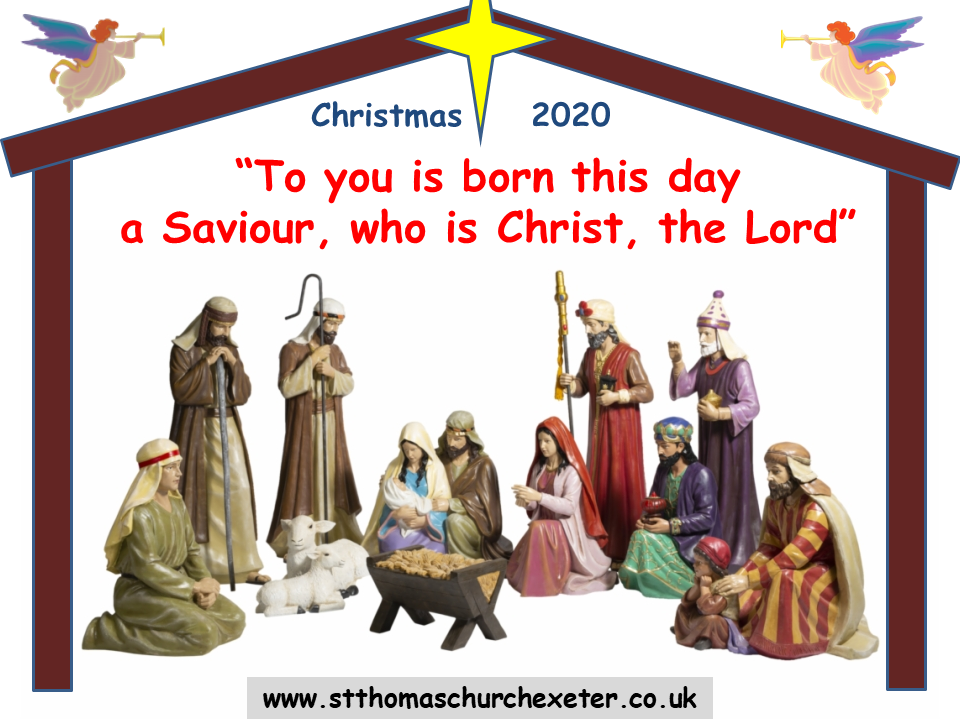
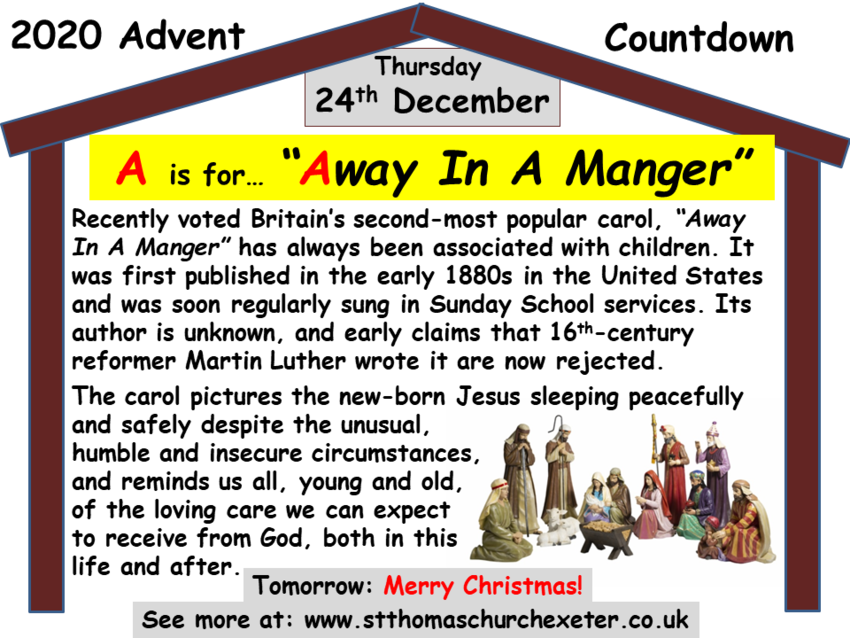
Advent Countdown, Thu 24th Dec: A
A is for... "Away In A Manger"
Recently voted Britain’s second-most popular carol, “Away In A Manger” has always been associated with children. It was first published in the early 1880s in the United States and was soon regularly sung in Sunday School services. Its author is unknown, and early claims that 16th-century reformer Martin Luther wrote it are now rejected (the earliest-known version in German, Luther's native language, dates from the 1930s).
The tune we sing it to, here in England, was composed by William Kirkpatrick, but other tunes have been used in the past, and in other countries.
The carol pictures the new-born Jesus sleeping peacefully and safely despite the unusual, humble and insecure circumstances, and reminds us all, young and old, of the loving care we can expect to receive from God, both in this life and after.
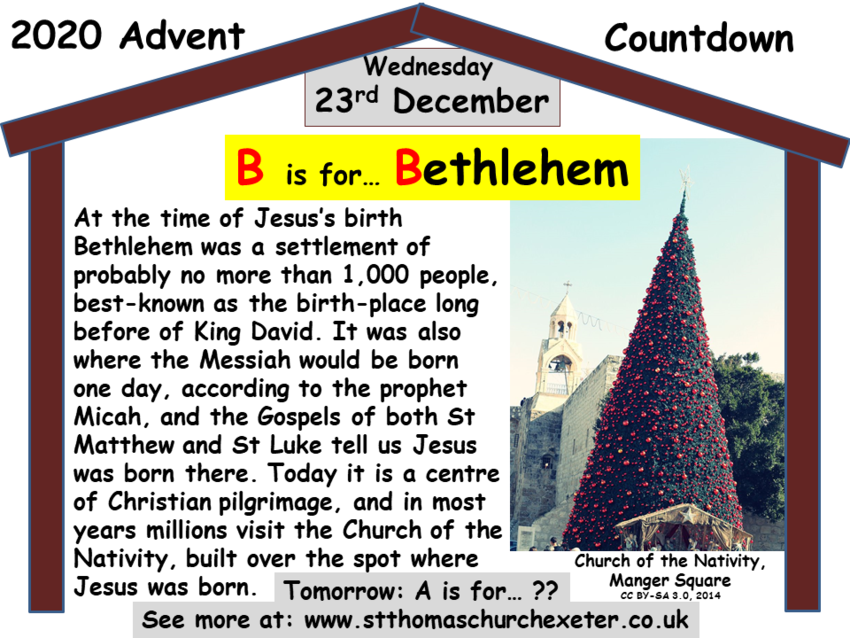
Advent Countdown, Wed 23rd Dec: B
B is for... Bethlehem
At the time of Jesus’s birth Bethlehem was a settlement of probably no more than 1,000 people, best-known as the birth-place, long before, of King David. Although sited just 7 or 8 miles south of Jerusalem, many of its inhabitants would have been farmers.
It was also where the Messiah would be born one day, according to the prophet Micah: "But you, O Bethlehem of Ephrathah, who are one of the little clans of Judah, from you shall come forth for me one who is to rule in Israel, whose origin is from of old, from ancient days." Both Gospels that mention Jesus's birth (St Matthew's and St Luke's) tell us it happened in Bethlehem.
Today, Bethlehem is a modern town of 25,000 people, many of them Palestinian Christians. It is situated on the West Bank, separated from Jerusalem by (and almost surrounded by) the barrier wall built by Israel. Its main income is from tourism, being a centre of Christian pilgrimage, and in most years millions of pilgrims visit the Church of the Nativity (on Manger Square; see the photograph), reputedly built over the spot where Jesus was born.
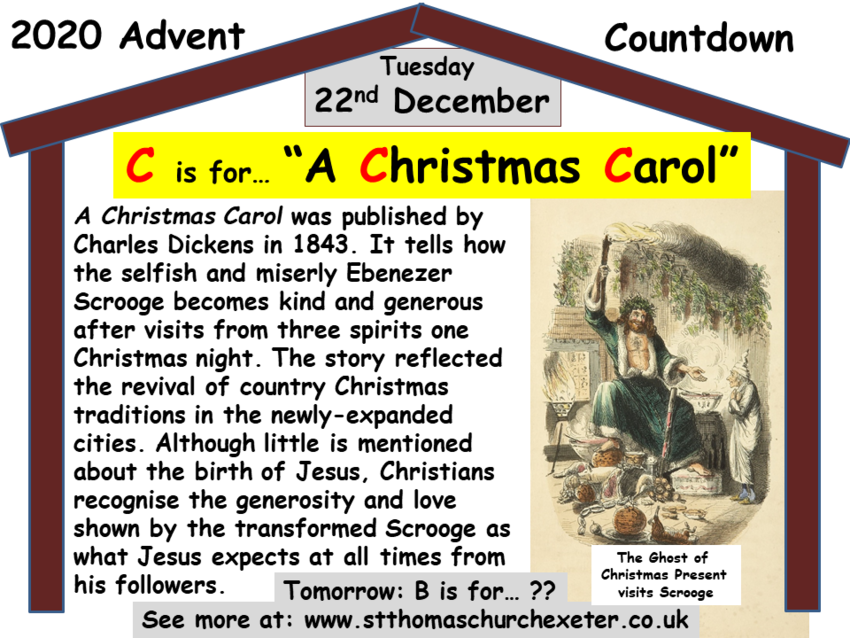
Advent Countdown, Tue 22nd Dec: C
C is for... "A Christmas Carol"
"God bless us, every one!"
A Christmas Carol was published by the author Charles Dickens in 1843. It tells how the selfish and miserly Ebenezer Scrooge becomes kind and generous after visits from the ghost of his former business partner Jacob Marley and three spirits one Christmas night.
At that time people in the newly-industrialised and recently-expanded towns and cities of England were reviving the older rural traditions they had lost, and the story reflected the revival of country Christmas traditions.
Little is mentioned in the novel about the birth of Jesus being central to the celebration of Christmas, though the Ghost of Christmas Present shows Bob Cratchit and his son Tiny Tim returning after a church service. But the transformation of Scrooge can be seen as a reminder that even the worst sinner can be brought back to God (by the Holy Spirit, rather than by ghosts). Also, Christians recognise the generosity and love shown by the transformed Scrooge as being what Jesus expects at all times from his followers.
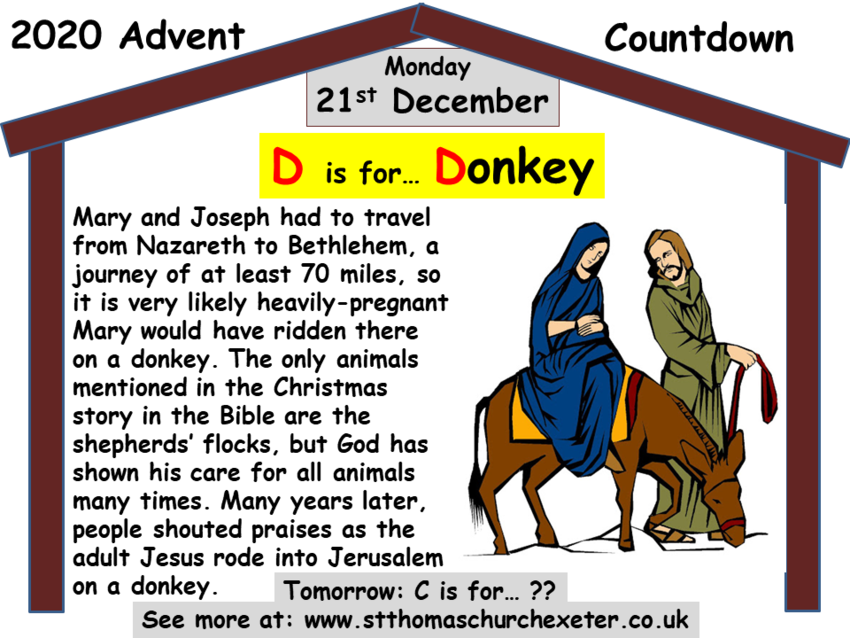
Advent Countdown, Mon 21st Dec: D
D is for... Donkey
Mary and Joseph had to travel from Nazareth to Bethlehem, a journey of at least 70 miles. That's comparable to the distance between Exeter and Bristol, but it would have been over much rougher roads. It might even have been further, if they had chosen to avoid travelling on the direct route through Samaria, as many Jews did. So it is very likely that heavily-pregnant Mary would have ridden there on a donkey, as many songs and images of the Christmas story show, though it's not mentioned in the Bible's account.
In fact the only animals mentioned explicitly in the Christmas story in the Bible are the shepherds’ flocks; no donkeys, no camels, no oxen (and - sorry, fans of Love, Actually - definitely not even one lobster!). However the wise men would probably have ridden camels or horses on their long journey, and cows or oxen would normally have used the feeding trough (the manger) that the new-born Jesus was laid in.
And God has shown his care for all animals many times, from the time of Noah onwards.
Many years later, people shouted praises and laid palm branches on the road as the adult Jesus rode into Jerusalem on a donkey. Christians celebrate that event every year on Palm Sunday, but they also remember that it was just a few days later that he was put to death on the cross.
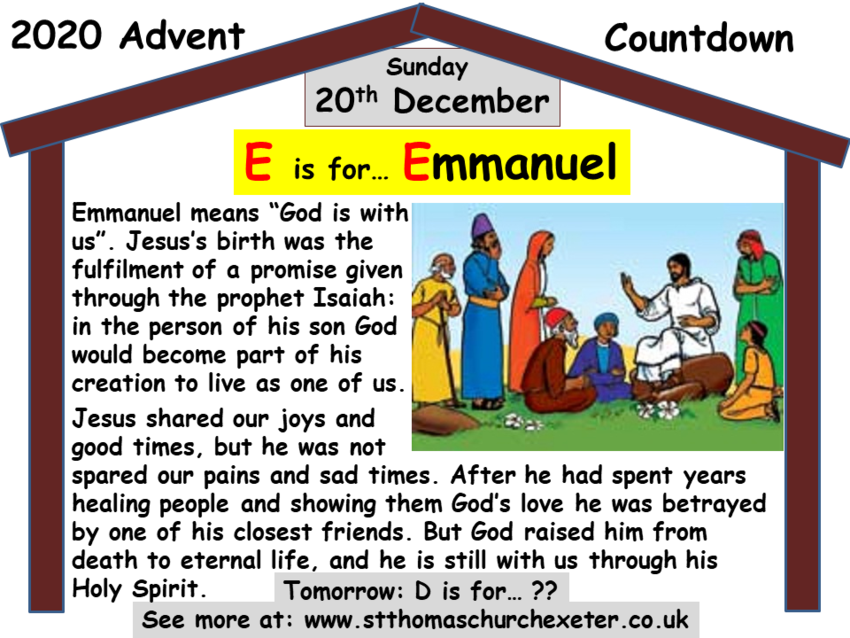
Advent Countdown, Sun 20th Dec: E
E is for... Emmanuel
Emmanuel (or Immanuel) means “God is with us”. Jesus’s birth was the fulfilment of a promise given through the prophet Isaiah: in the person of his son God would become part of his creation to live as one of us.
Jesus wasn't just a "tourist from heaven", but shared all our joys and good times: in the Gospels we read that he went to wedding celebrations and enjoyed eating and travelling with his friends. Nor was he spared our pains and sad times. Along with all the trivial discomforts such as we get from walking long distances on hot and stoney roads, after he had spent years healing people and showing them God’s love he was betrayed to his violent enemies by one of his closest friends.
But after God raised him from death to eternal life, and took him into heaven, Christians know that he is still with us through his Holy Spirit, which he gives to all who follow him.
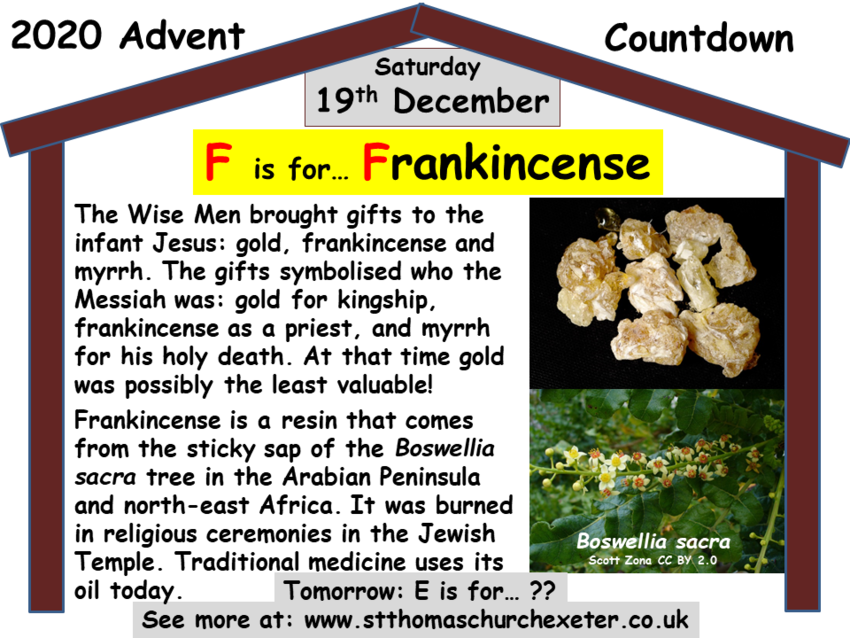
Advent Countdown, Sat 19th Dec: F
F is for... Frankincense
The Wise Men brought gifts to the infant Jesus: gold, frankincense and myrrh. The gifts symbolised who the Messiah was: gold for kingship, frankincense for his role as a priest, and myrrh for his holy death. Surprisingly, at that time gold was possibly the least valuable of the three, weight for weight!
Frankincense is a resin that comes from the sticky sap of the Boswellia sacra tree in the Arabian Peninsula and north-east Africa. Around the time Jesus was born it was burned in religious ceremonies in the Jewish Temple to produce a pleasant smell, and to show our prayers rising to God.
Today frankincense oil (produced by steaming the resin blocks) is used in aromatherapy and in traditional medicine. It can sometimes be found in local health-food shops.
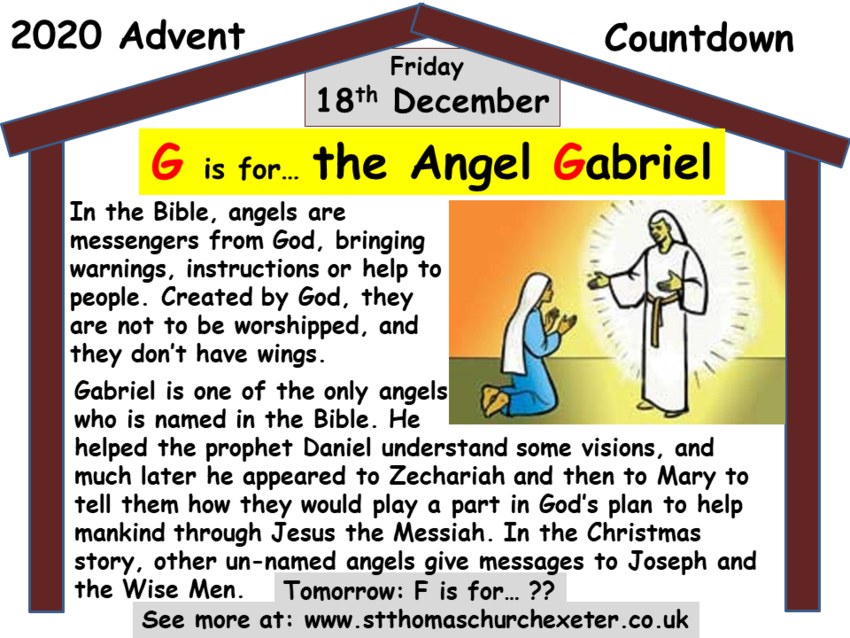
Advent Countdown, Fri 18th Dec: G
G is for... the Angel Gabriel
In the Bible, angels are messengers from God (the greek word angelos means "messanger"). They bring warnings, instructions or help to people. Along with other heavenly beings, they were created by God, we are told not to worship them, and unlike in most popular images angels don’t have wings! They have authority and power and do God's will.
Gabriel is one of the only angels who is named in the Bible. Around 600 years before Jesus was born he helped the prophet Daniel understand some visions (you can read about this in chapters 8 and 9 of the Book of Daniel).
Much later, shortly before Jesus was born, he appeared to Zechariah and then to Mary to tell them how they would play a part in God’s plan to help mankind through Jesus the Messiah.
In other parts of the Christmas story, other un-named angels give messages and warnings to Joseph and the Wise Men.
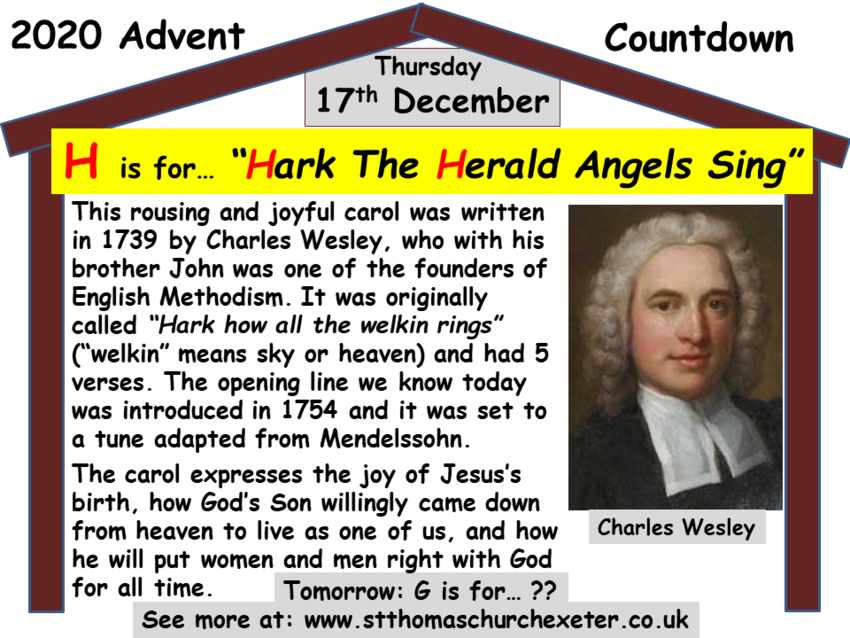
Advent Countdown, Thu 17th Dec: H
H is for... "Hark! The Herald Angels Sing"
This rousing and joyful carol was written in 1739 by Charles Wesley, who with his brother John was one of the founders of English Methodism and who wrote many other poular hymns.
It was originally called “Hark how all the welkin rings” (“welkin” means sky or heaven) and had 5 verses (see below). The carol was adapted in the 1750s by George Whitefield (another founder of English Methodism), changing the opening line to the one we sing today and cutting the last two verses, and further minor adaptions were made for a publication in the 1780s, including adding the refrain at the end of each verse. In the mid-1800s it was set to a tune adapted from a piece written by the composer Mendelssohn.
Today the carol is often sung as the last item in carol services.
The carol expresses the joy of Jesus’s birth, how God’s Son willingly came down from heaven to live as one of us, and how he will put women and men right with God for all time.
You can watch the choir of King's College, Cambridge singing the carol here.
The words we sing today:
1. Hark! The herald-angels sing
"Glory to the newborn king;
Peace on earth and mercy mild,
God and sinners reconciled"
Joyful all ye nations rise,
Join the triumph of the skies
With the angelic host proclaim
"Christ is born in Bethlehem"
Hark! The herald-angels sing
"Glory to the new-born king"
2. Christ, by highest heav'n adored
Christ, the everlasting Lord,
Late in time behold Him come
Offspring of a Virgin's womb:
Veiled in flesh the Godhead see,
Hail the incarnate Deity
Pleased as man with man to dwell
Jesus, our Emmanuel
Hark! The herald-angels sing
"Glory to the newborn King"
3. Hail the Heav'n-born Prince of Peace!
Hail the Son of Righteousness!
Light and life to all He brings,
Risen with healing in His wings;
Mild He lays His glory by
Born that man no more may die
Born to raise the sons of earth
Born to give them second birth
Hark! The herald angels sing
"Glory to the new-born king"
And here are the original first verse, as written by Charles Wesley, and the fourth and fifth verses (the fourth verse is occasionally sung today, the fifth almost never):
1. HARK how all the Welkin rings
"Glory to the King of Kings,
"Peace on Earth, and Mercy mild,
"GOD and Sinners reconcil'd!
Joyful all ye Nations rise,
Join the Triumph of the Skies,
Universal Nature say
"CHRIST the LORD is born to Day!
4. Come, Desire of Nations, come,
Fix in Us thy humble Home,
Rise, the Woman's Conqu'ring Seed,
Bruise in Us the Serpent's Head.
Now display thy saving Pow'r,
Ruin'd Nature now restore,
Now in Mystic Union join
Thine to Ours, and Ours to Thine.
5. Adam's Likeness, LORD, efface,
Stamp thy Image in its Place,
Second Adam from above,
Reinstate us in thy Love.
Let us Thee, tho' lost, regain,
Thee, the Life, the Inner Man:
O! to All Thyself impart,
Form'd in each Believing Heart.

Advent Countdown, Wed 16th Dec: I
I is for... Isaiah
Isaiah is one of the greatest of the Old Testament prophets, and the words God gave him to speak to the Jews in the Kingdoms of Israel and Judah can be found in the book named after him. God called him to be a prophet, sending a great vision, in the year that Uzziah, King of Judah, died (c740 BC). Isaiah continued to speak God’s words for around half a century, through the times of King Jotham and King Ahaz, until the end of King Hezekiah’s reign (698 BC). During this time the northern Kingdom of Israel was conquered and destroyed by the neighbouring Assyrians, who then threatened the southern Kingdom of Judah. Isaiah prophesied that Judah would be saved from destruction at that time.
Isaiah also prophesied about a coming servant of God who would be made to suffer and through doing so would heal many other people. Christians see these prophecies as speaking about Jesus’s life, death and resurrection, and identify Jesus as the "Suffering Servant".
Concerning the birth of Jesus, the Messiah, chapter 1 of St Matthew's Gospel quotes Isaiah: "Look, the virgin shall conceive and bear a son, and they shall name him Emmanuel" (which means "God is with us").
Isaiah is quoted more than any other prophet by New Testament writers. A full list of the quotes can be found here.
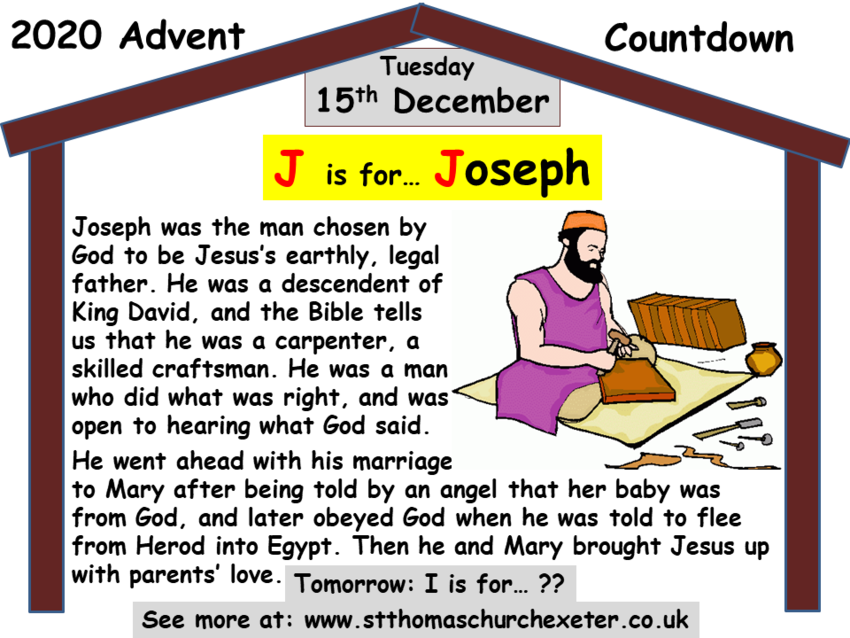
Advent Countdown, Tue 15th Dec: J
J is for... Joseph
Joseph, son of Jacob, was the man chosen by God to be Jesus’s earthly, legal father. He was a descendent of King David, so his ancestral home was Bethlehem, although St Luke's Gospel tells us he was living in Nazareth before Jesus was born. Later on in St Matthew's Gospel Jesus is described (by the people of Nazareth) as "the carpenter's son", the word used suggesting a skilled craftsman rather than a "chippy". He was a man who did what was right, and he was open to hearing what God said.
He was engaged ("betrothed") to Mary when she began to bear Jesus. He intended to call the wedding off, but after an angel told him that the baby was part of God's plan and would be God's son, the Messiah, he went ahead with his marriage to Mary. He led Mary to Bethlehem when the census required it, and later obeyed God when he was told (again, by an angel) to flee with Mary and the infant Jesus from Herod into Egypt and live there for a while.
Later, after King Herod died, Joseph and Mary returned to Nazareth, where he and Mary brought Jesus up with all the love parents show their children.
We are not told when he died, but the Gospels suggest his death happened some time before the grown-up Jesus was baptised and started his ministry.
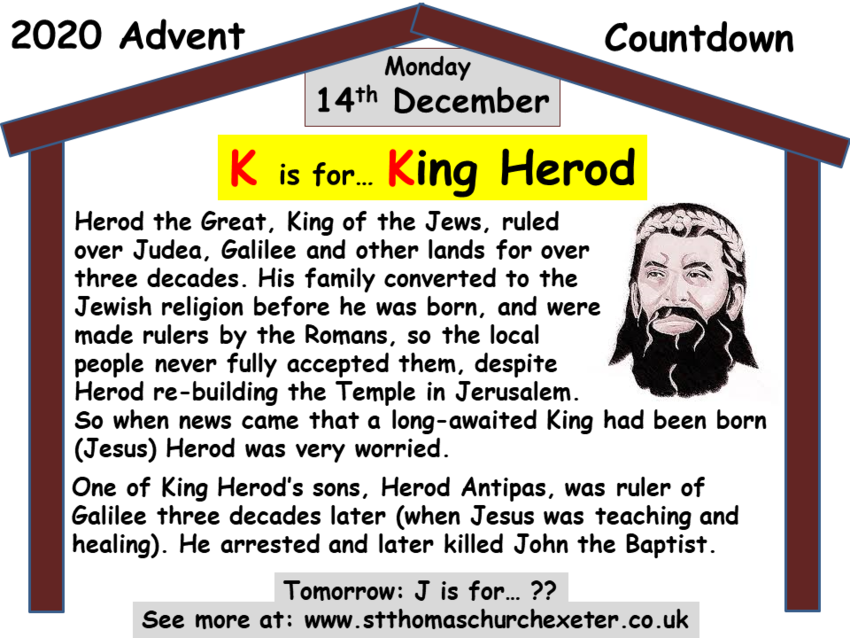
Advent Countdown, Mon 14th Dec: K
K is for... King Herod
Herod the Great, King of the Jews, ruled over Judea, Galilee and other lands for over three decades. His family converted to the Jewish religion before he was born, and Herod's father was made a local governor by the Romans. Herod himself was appointed provincial governor of Galilee, but was later appointed King of the Jews by the Roman Senate and backed to take over (by force) neighbouring Judea (including Jerusalem). This background, his family's un-holy lifestyle and his own cruelty as ruler meant that the Jewish people never fully accepted him as king, despite Herod spending lots of money on various building projects. The most famous of these is the re-building of the Temple in Jerusalem, the centre of Jewish worship, which involved building up the Temple Mount, still surviving today.
So when news came that a long-awaited King, the Messiah, had been born Herod was very worried that the people might try to depose and kill him. He therefore tried to have the threat removed, but he failed; through a warning by an angel Mary and Joseph took Jesus away to safety until Herod died a few years later.
One of King Herod’s sons, Herod Antipas, was ruler of Galilee three decades later (when Jesus was teaching and healing). John the Baptist condemned his un-holy lifestyle, so Herod Antipas had him arrested and later had him killed.
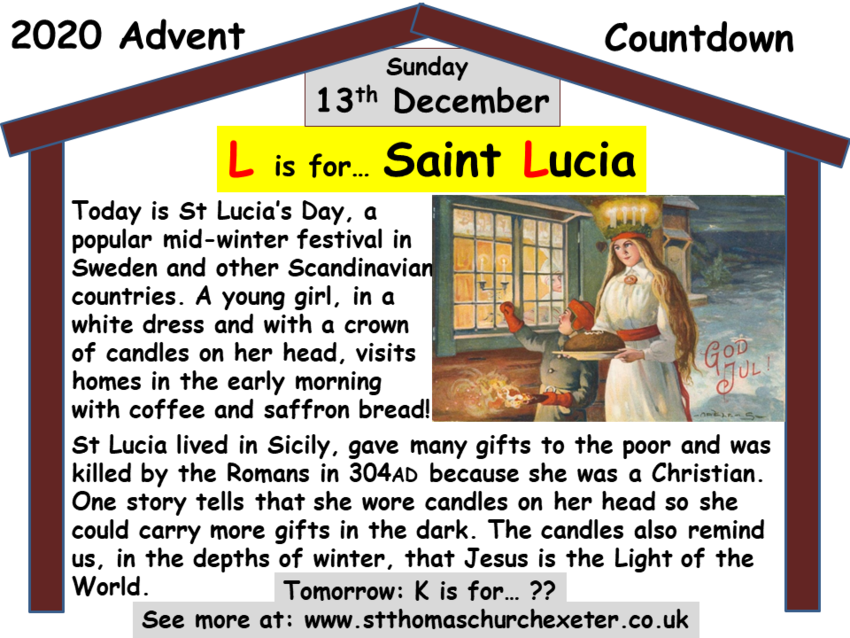
Advent Countdown, Sun 13th Dec: L
L is for... Saint Lucia (St Lucy)
Today is St Lucia’s Day, a popular mid-winter festival in Sweden and other Scandinavian countries. A young girl (usually the eldest daughter of the family), in a white dress with a red sash and with a crown of candles on her head, visits homes in the early morning bringing coffee and saffron bread (lussekatter). More recently, towns have elected a girl to represent St Lucia who leads a procession of other children, both girls and boys. There are several hymns and songs that are traditionally sung.
St Lucia's Day is also a popular festival in Italy, although with different traditions.
St Lucia lived in Sicily (a long way south of Sweden, and much warmer!), and was known for giving many gifts to the poor (including, it is said, the money for her wedding dowry). One story tells that she wore candles on her head so she could carry more food and gifts to threatened Christians hiding from the Romans in dark caves. She was killed by the Romans in 304 A.D. during a particularly bad period of persecution because she was a Christian.
Before the switch a few hundred years ago from using the Julian calendar to the Gregorian calendar (which we use today) St Lucia's Day fell on the shortest day of the year, so the light from the candles that are part of the festival was particularly welcome. Since it always falls during advent, when we look ahead to the coming of Jesus, it is also a reminder that the Messiah is the Light of the World.
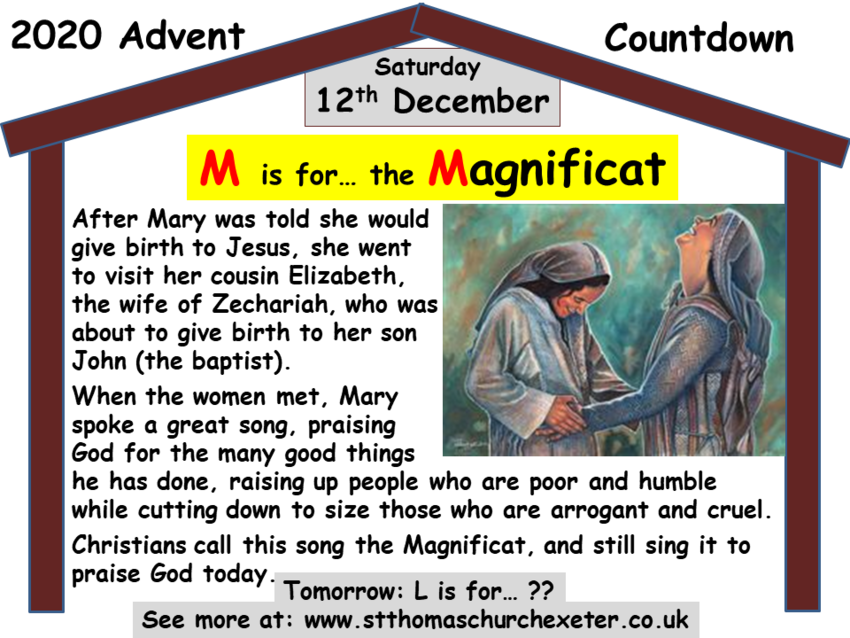
Advent Countdown, Sat 12th Dec: M
M is for... the Magnificat
Sorry, feline-lovers, it's not an amazing puss!
After Mary was told she would give birth to Jesus, she went to visit her older cousin Elizabeth, the wife of Zechariah, who was about to give birth to her son John (the baptist). (Zechariah was featured in this countdown under "Z".)
When the women met, St Luke's Gospel tells us that the unborn baby in Elizabeth's womb leapt for joy at the sound of Mary's voice, sensing that she was bearing the unborn Jesus. In response Mary spoke a great song, praising God for the many good things he has done, raising up people who are poor and humble while cutting down to size those who are arrogant and cruel.
Christians call this song the Magnificat, and still sing it to praise God today. You can read the words in the first chapter of St Luke's Gospel.
The words have been set to music many times, but in the early 1960s Timothy Dudley-Smith wrote the song "Tell Out My Soul" based closely on the Magnificat, and you can hear it being sung here (from BBC Songs of Praise, recorded in St Anne's Cathedral, Belfast)
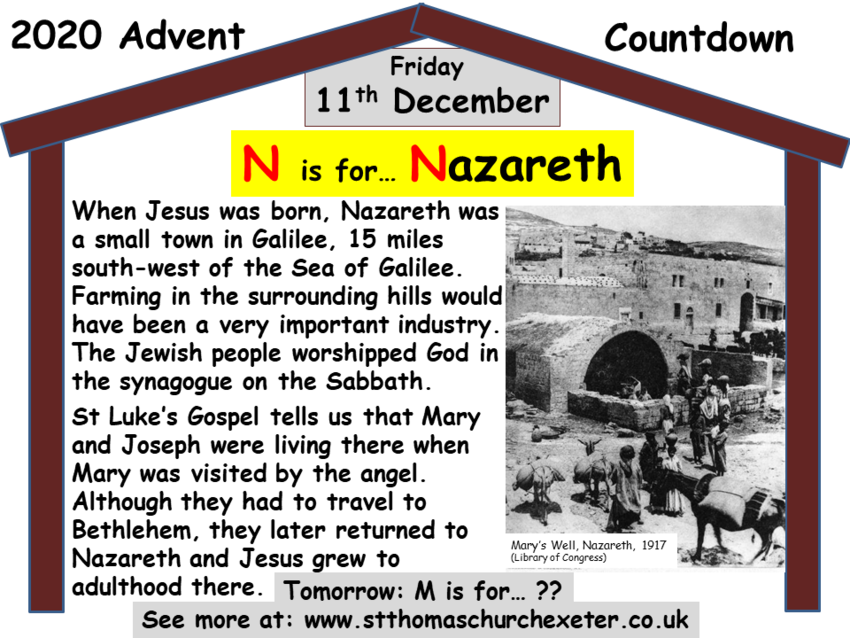
Advent Countdown, Fri 11th Dec: N
N is for... Nazareth
When Jesus was born, Nazareth was a small town in Galilee, 15 miles south-west of the Sea of Galilee. Farming in the surrounding hills would have been a very important industry. The Jewish people worshipped God in the synagogue on the Sabbath.
St Luke’s Gospel tells us that Mary and Joseph were living there when Mary was visited by the angel.
Although they had to travel to Bethlehem, they later returned to Nazareth and Jesus grew to adulthood there. It was therefore quite natural for people to refer to him as "Jesus of Nazareth".
Today Nazareth still has an older part (though the buildings there date back "only" a few hundred years, and so were built well over a thousand years after Jesus lived there). But there are many modern buildings as well, and it is home to around 80,000 people. Each year many tourists and Christian pilgrims travel there and visit the Church of the Annunciation (believed to be built on the spot where the angel spoke to Mary) and various other sites that claim a link to Mary or Joseph (such as Mary's Well, pictured).
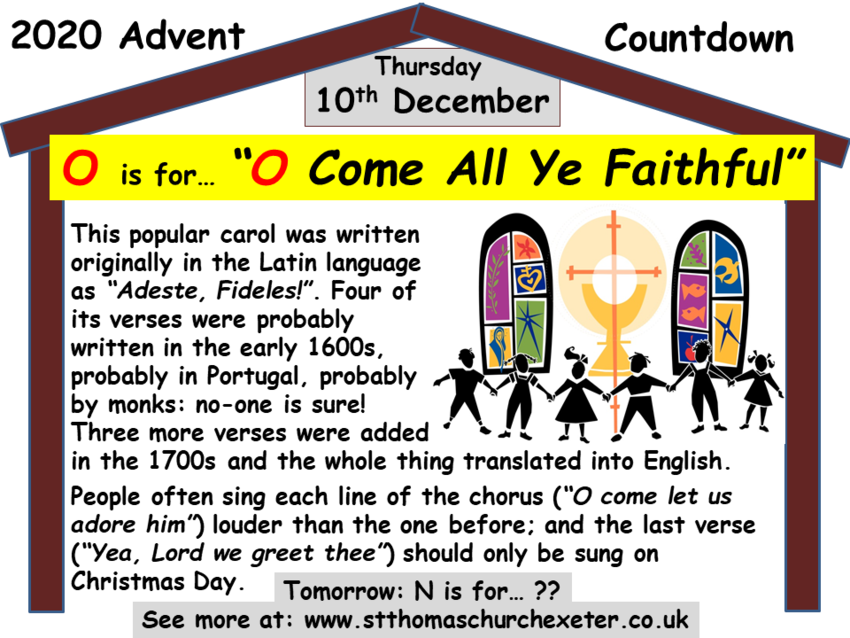
Advent Countdown, Thu 10th Dec: O
O is for... "O Come All Ye Faithful"
This popular carol was written originally in the Latin language as “Adeste, Fideles!”. Four of its verses were probably written in the early 1600s, probably in Portugal, probably by monks: no-one is sure! The original four verses are the ones beginning "O come, all ye faithful", "God of God", "Sing, choirs of angels" and "Yea, Lord, we greet thee"; these were translated by Frederick Oakley.
Three more verses were added in the 1700s ("See how the shepherds", "Lo! star-led chieftains" and "Child, for us sinners") again at first in Latin and then translated into English. With those extra verses the whole story of Christ's nativity, including details from both St Matthew's and St Luke's Gospels, is told.
People often sing each line of the chorus (“O come let us adore him”) louder than the one before, but properly a different part of the choir should come in for each line, so the first line is sung only by sopranos, then the second line also by tenors/altos, and finally the basses join in the third line. The last verse (“Yea, Lord we greet thee”) is only really suitable to be sung on Christmas Day itself because of the second line "born this happy morning".
You can see and hear the choir of King's College Cambridge singing the original four verses here.
And here are all seven verses commonly sung in English (reproduced here because they are not found together on the internet as often as you might imagine!):
1. O come, all ye faithful,
joyful and triumphant,
O come ye, O come ye, to Bethlehem.
come and behold him,
born the King of angels;
O come, let us adore him!
O come, let us adore him!
O come, let us adore him,
Christ the Lord.
2. God of God,
Light of Light,
lo, he abhors not the Virgin’s womb;
very God,
begotten, not created;
O come, let us adore him…
3. See how the shepherds,
summoned to his cradle,
leaving their flocks, draw nigh with lowly fear;
we too will thither
bend our joyful footsteps;
O come, let us adore him…
4. Lo! star-led chieftains,
Magi, Christ adoring,
offer him incense, gold, and myrrh;
we to the Christ-child
bring our hearts’ oblations.
O come, let us adore him…
5. Child, for us sinners,
poor and in the manger,
fain we embrace thee, with love and awe;
who would not love thee,
loving us so dearly?
O come, let us adore him…
6. Sing, choirs of angels,
sing in exultation;
sing, all ye citizens of heav'n above!
glory to God,
in the highest;
O come, let us adore him…
7. Yea, Lord, we greet thee,
born this happy morning;
Jesu, to thee be glory giv'n;
Word of the Father,
now in flesh appearing.
O come, let us adore him…
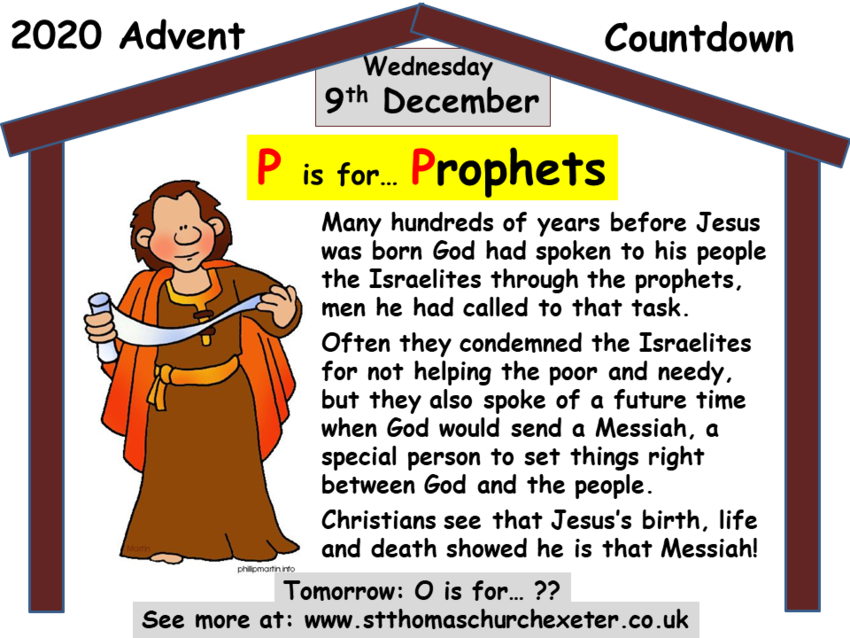
Advent Countdown, Wed 9th Dec: P
P is for... Prophets
Many hundreds of years before Jesus was born God had spoken to his people the Israelites through the prophets, men he had called to that task. 16 books in the Bible's Old Testament are credited to prophets: Isaiah, Jeremiah, Ezekiel and Daniel, plus 12 "minor" prophets, Hosea, Joel, Amos, Obadiah, Jonah, Micah, Nahum, Habakkuk, Zephaniah, Haggai, Zechariah and Malachi. The words given by the Lord to other prophets are also recorded in other books, such as the words of Nathan in the 2nd book of Samuel.
Often they condemned the Israelites for not helping the poor and needy, but they also spoke of a future time when God would send a Messiah, the "Annointed One", a special person to set things right for all time between God and the people.
Prophets who are understood to have spoken about the Messiah (and his birth) include Isaiah, Jeremiah, Daniel, Hosea, Micah, Zechariah (not the priest who featured for "Z") and Malachi. Many of the Psalms also clearly speak about God's coming "Annointed One".
Christians see that Jesus’s birth, life and death fulfilled these prophecies and showed that he is the long-awaited Messiah! However the way he brought the people back to a right relationship with God was not how many people at the time expected.

Advent Countdown, Tue 8th Dec: Q
Q is for... Quirinius
When Jesus was born, the Romans ruled the land the Jewish people lived in, and their empire included all the lands around the Mediterranean Sea, and also what is now France and Belgium. They would conquer Britain (or most of it) within the following 50 years, and the empire lasted over 400 more years.
The Romans brought many benefits to the peoples they had conquered (aqueducts, for example), but they were cruel and ruthless if they were opposed. There could be no doubt that they were in charge.
Quirinius was the governor of the neighbouring Roman province of Syria when the Emperor Augustus ordered a census to be taken across the empire.
Joseph and his pregnant wife Mary would have to travel many miles to Bethlehem so they could be registered in the city where Joseph’s family historically came from.
You can read about the ordering of the Roman census in chapter 2 of St Luke's Gospel.
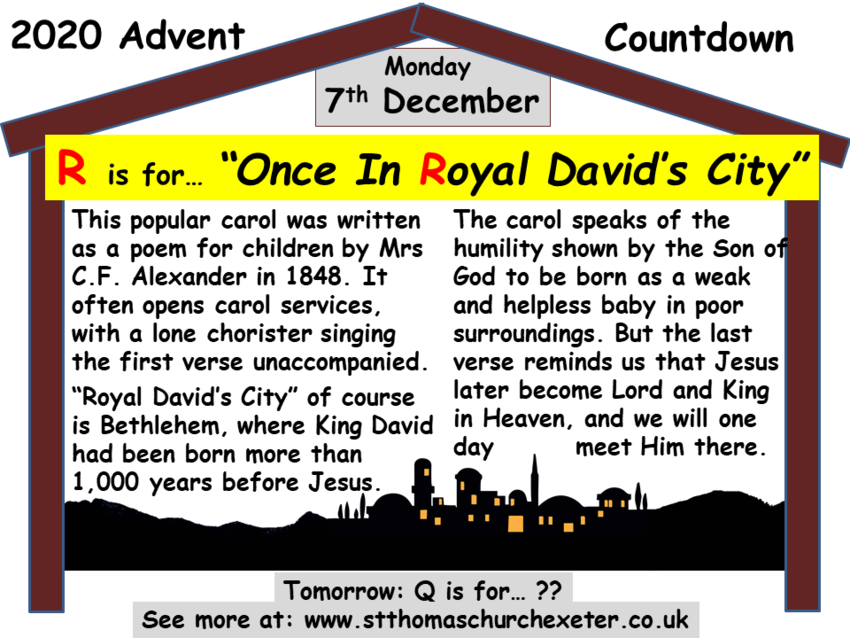
Advent Countdown, Mon 7th Dec: R
R is for... "Once In Royal David's City"
This popular carol was written as a poem for children by Mrs Cecil Frances Alexander in 1848, and set to music shortly afterwards. Her husband was an Anglican Bishop in Ireland, and Cecil herself worked hard to help children living in poverty. She wrote a number of well-known hymns, including "All Things Bright And Beautiful" and "There Is A Green Hill Far Away".
“Royal David’s City” is, of course, Bethlehem, where King David had been born more than 1,000 years before Jesus.
The carol speaks of the humility shown by the Son of God, who had been involved in the creation of everything, to be born as a weak and helpless baby in the poor surroundings of a stable. But the last verse reminds us that, after he had lived a life of service, died on the cross and been raised to life again, Jesus became Lord and King in Heaven, and we will one day meet him there.
"Once In Royal David's City" often opens carol services, with a lone chorister singing the first verse unaccompanied. You can read the words here.
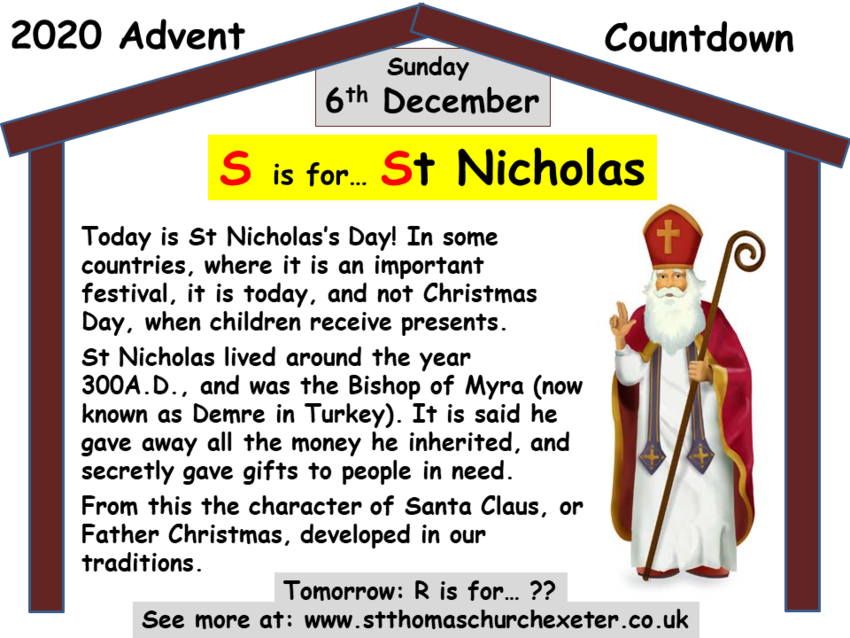
Advent Countdown, Sun 6th Dec: S
S is for... Saint Nicholas
Happy St Nicholas's Day! Yes, today is the church's feast-day when the life of Saint Nicholas is celebrated.
Although it's not a big event here in England, it is very important in many other European countries. In some places, it is on this day, rather than on Christmas Day, that children traditionally receive small gifts.
In the Netherlands, for example, on the evening before children will put out a shoe with some hay and a carrot for St Nicholas's horse, and hope that in the morning that will be replaced by some sweets. There are other similar traditions in other countries.
So who was St Nicholas?
Nicholas lived around the year 300 A.D. (possibly from 270 to 343). He came from a wealthy Christian family who lived in the part of the Roman Empire that is now in Turkey. When his parents died he is said to have given away all the money he inherited, because he understood that Jesus told his followers to be generous. He became the Bishop of Myra (a place now called Demre, also in Turkey), and many stories are told of him giving gifts secretly to people who were particularly in need. It is thought he died on 6th December, which is why he is celebrated then.
It is from his secret giving of gifts that he became known as Santa Claus ("Sant Niclaus" in germanic languages), who children wait for excitedly at Christmas today.
You can read a famous poem about a Christmas visit from St Nicholas here.
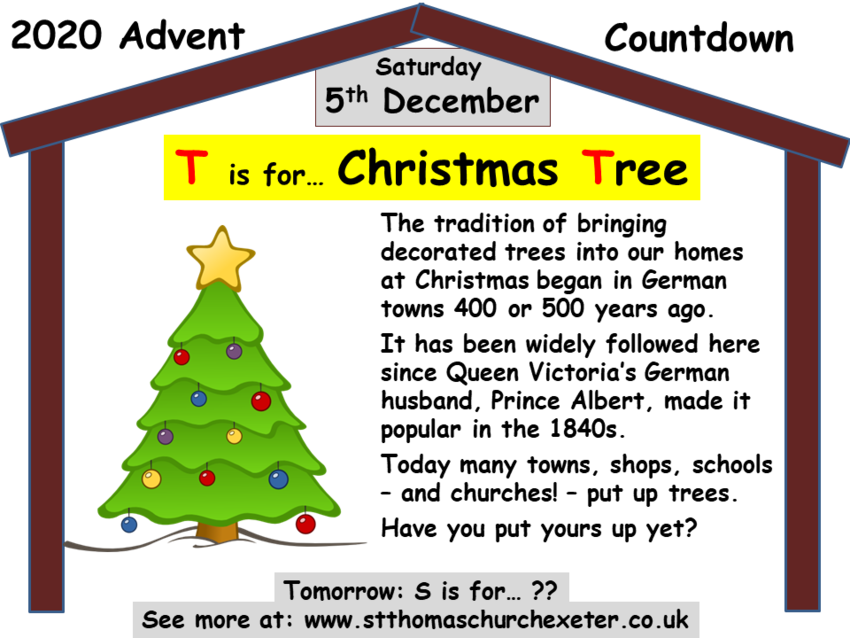
Advent Countdown, Sat 5th Dec: T
T is for... Christmas Tree
Bringing decorated trees into our houses is a common tradition at Christmas-time in England and many other countries.
The tradition started in German towns 400 or 500 years ago, and became widely followed here in the 1840s after Queen Victoria’s German husband, Prince Albert, popularised it.
Sometimes the trees we put up are real, living ones that can be re-planted outside after the Christmas season is over and used again in following years, but sometimes they are artificial and can be stored from year to year in a cupboard or attic!
Many towns, shops, schools – and churches! – put up trees. The tree that is put up in Trafalgar Square in the middle of London is given every year by the people of Oslo in Norway, to say "thank you" for help they were given during World War 2.
Long before the peoples of Europe became Christian they used fir trees in their festivals around this time of year. Being evergreen, fir trees were a reminder that the dark and cold days when everything appears to have died will not last forever. Now, for Christians they can be seen to represent the eternal life that Jesus brings.
Have you put your tree up yet?
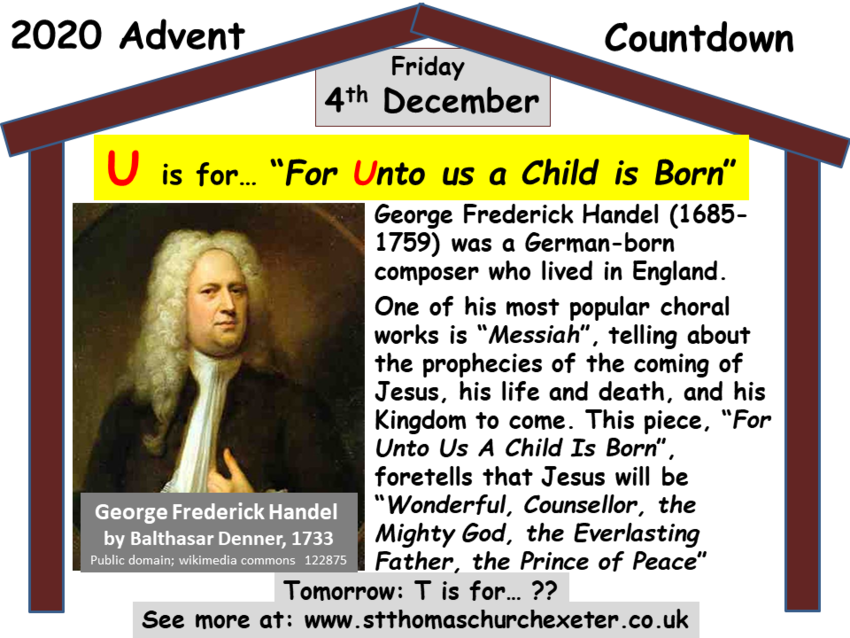
Advent Countdown, Fri 4th Dec: U
U is for... "for Unto us a child is born"
German-born composer George Frederick Handel lived from 1685 to 1759, and spent most of his adult life in England. During the 1740s he wrote a famous musical work for choir and orchestra, “Messiah” (with the words written by Charles Jennens).
It describes the prophecies about Jesus the Messiah’s coming, his birth, his life and his death on the cross and what that means for all of us. It is one of the most popular and well-regarded choral works ever.
This piece, "For Unto Us A Child Is Born", tells one of the prophecies about Jesus’s life and reign as God and King, calling him “Wonderful, Counsellor, the Mighty God, the Everlasting Father, the Prince of Peace”.
You can hear a choir singing this piece here (may be ads).
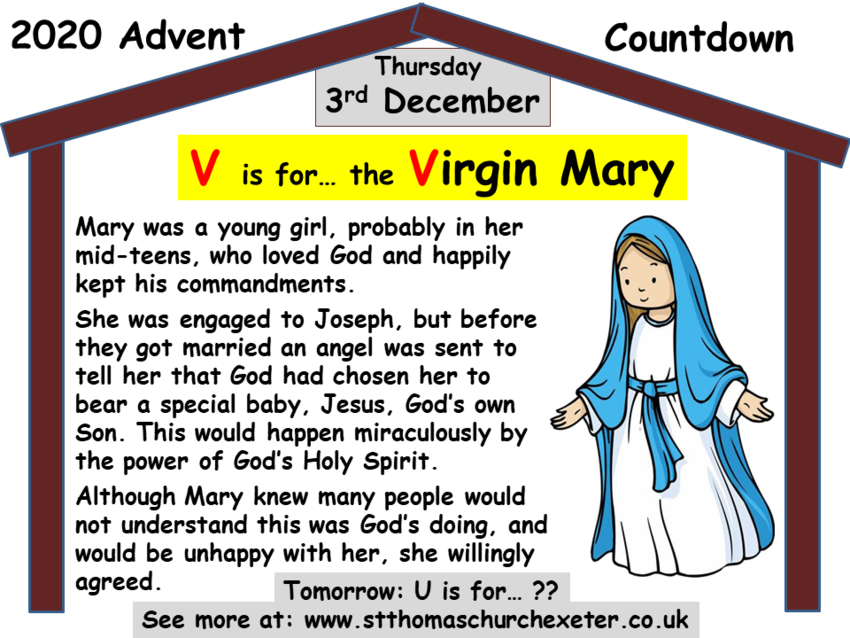
Advent Countdown, Thu 3rd Dec: V
V is for... the Virgin Mary
Mary was a young Jewish girl, probably only in her mid-teens. She loved God, kept his commandments, and lived a holy and kind life.
She was engaged to be married (betrothed) to Joseph. But before the ceremony took place, an angel (called Gabriel) appeared to her with amazing and important news: she had been chosen to bear a special baby, Jesus, God's own son! This would happen miraculously, by the power of God's Holy Spirit.
Mary knew that this was a great honour, but also a great responsibility. She and Joseph would have to give a safe and loving home to Jesus as he grew up to do great things in God's service. Mary also knew that many people would not understand that this was God's doing, and would be angry with her. Despite all that, she willingly agreed to be part of God's plan and be Jesus's mother.
You can read this part of Mary's story in chapter 1 of St Luke's Gospel.
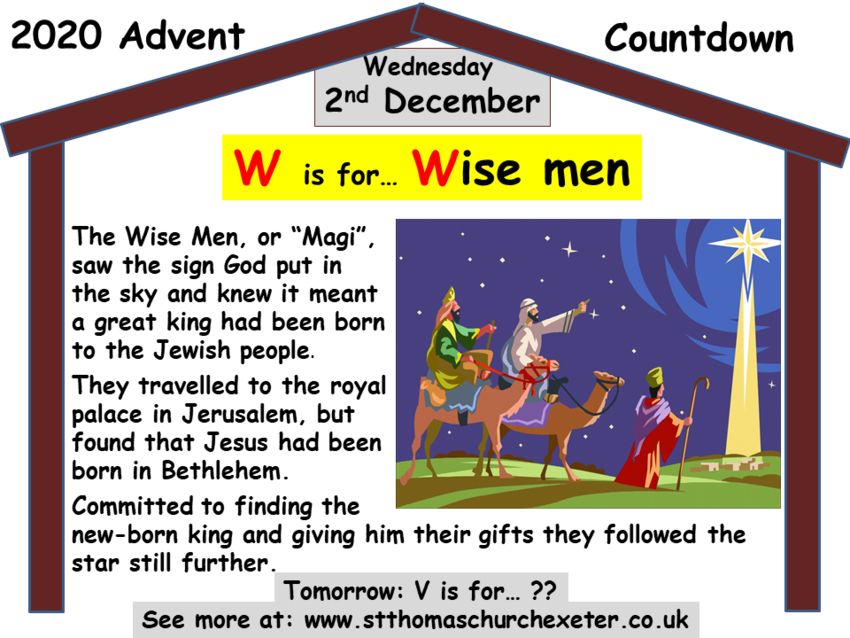
Advent Countdown, Wed 2nd Dec: W
W is for... Wise Men
St Matthew’s Gospel tells us about wise men, or “Magi”, who saw the sign in the night sky and knew it meant that a new and important king had been born to the Jewish people.
They expected the baby king to have been born as the son of the existing king, Herod the Great, so they went to the Royal Palace in Jerusalem. But Jesus had been born in much humbler circumstances in Bethlehem, and his father was God in Heaven, not any king on Earth.
Having been told that the special king, the Messiah, would be born in Bethlehem, the wise men travelled the short distance from Jerusalem (shorter than the distance from Exeter to Exmouth!) and gave their gifts to Jesus.
These men are often referred to as kings themselves, and they may have ruled small local kingdoms, but mainly they were people who watched the movements of the stars in the sky and learned the wisdom of their day.
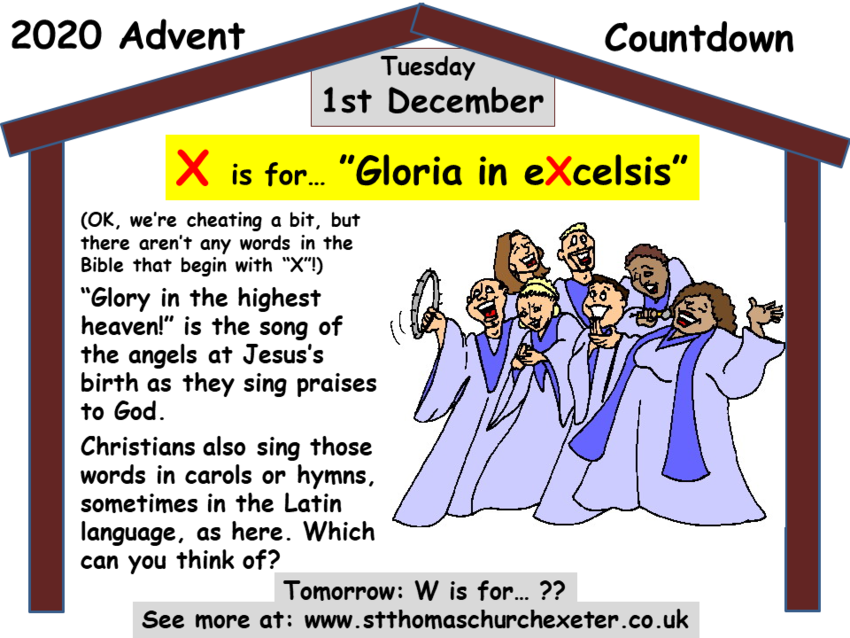
Advent Countdown, Tue 1st Dec: X
X is for... "Gloria in eXcelsis!", "Glory in the highest heaven!"
(OK, we’re cheating a bit here, but there are no names, or even any words, beginning with the letter X in the traditional King James version of the Bible. So we hope all you people of X-eter will allow us some leeway, in the generous spirit of Xmas!)
The joyful songs and shouts of praise to God from the angels when Jesus was born amazed the shepherds who saw and heard them. Their words are often put into carols and other songs in the Latin language, like in “Ding Dong! Merrily on high”. (You can watch the choir of King's College Cambridge singing this carol here; there may be adverts!)
Can you think of any other carols where we sing this?
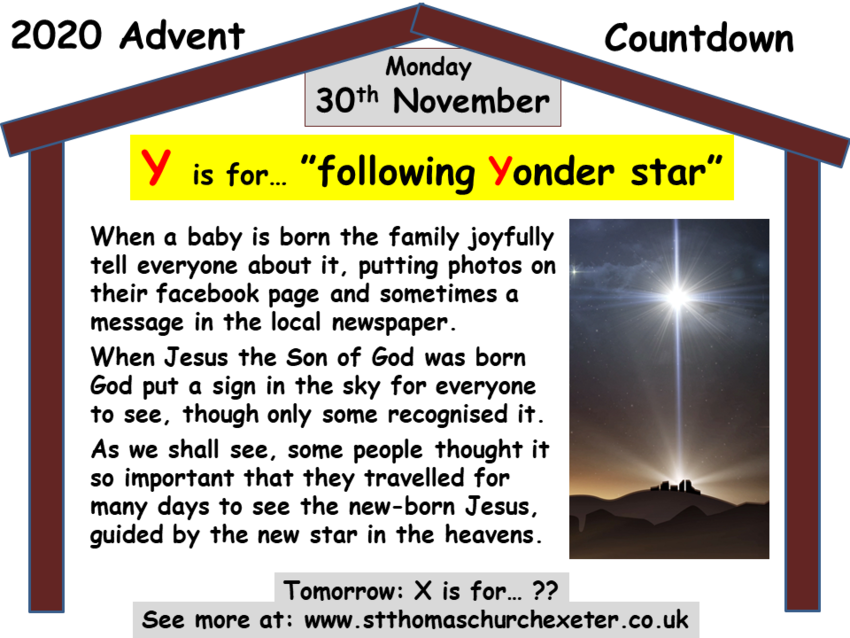
Advent Countdown, Mon 30th Nov: Y
Y is for... "following Yonder star"
When a baby is born in a family they joyfully tell everyone about it, putting pictures on their facebook page and sometimes a message in the local newspaper. When Jesus the Son of God was born God put a sign in the sky for everyone to see (though only some recognised it).
In the Bible (chapter 2 of St Matthew's Gospel) the wise men speak of a star that they saw newly rising in the sky. Modern astronomers have suggested several things it could have been:
- a distant, old star that dies by exploding (what is misleadingly called a nova or a supernova)
- a comet (several were seen around that time - but they were usually regarded as bad omens, not good news)
- a "dance" of two planets as they appear from the Earth to pass each other (the technical term is a "conjunction")
Whatever it was, it told experienced sky-watchers who had read much of the wisdom of their day that something great and wonderful had happened, and they set off, as the carol says, "following yonder star".
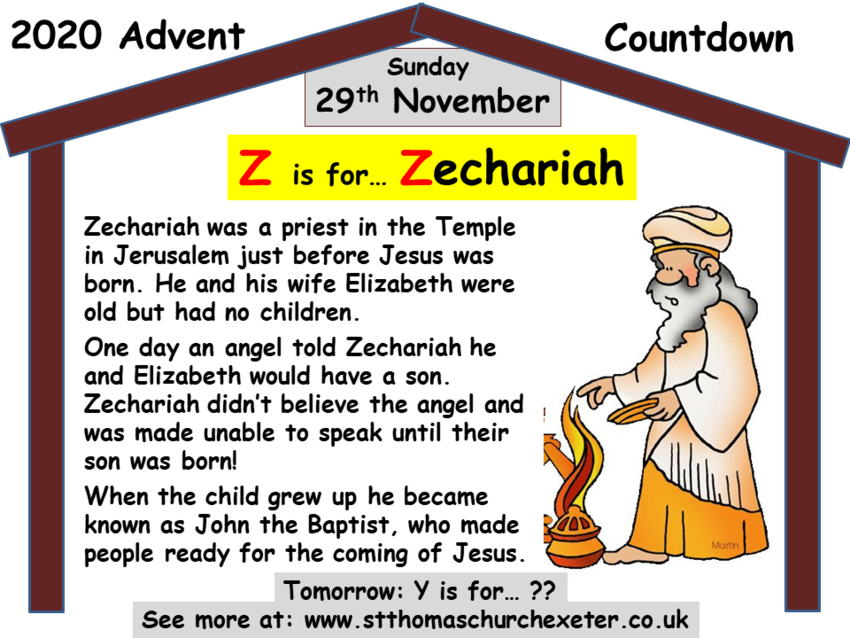
Advent Countdown, Sun 29th Nov: Z
Z is for... Zechariah
Zechariah was a priest in the Temple in Jerusalem in the years before Jesus was born. He and his wife Elizabeth, who was a cousin of Mary the mother of Jesus, were getting old but had not been able to have any children.
One day an angel appeared to Zechariah and told him that he and Elizabeth would have a son, who would be the forerunner of the long-awaited Messiah of the Jewish people; they should name the boy John.
Zechariah found it hard to believe the angel, so he was made unable to speak. But when the baby was born, just as the angel had said, Zechariah wrote that the child should be named John, and he was then able to speak again and praised God.
The boy grew up to be known as John the Baptist, who encouraged the people to get ready for Jesus.
You can read Zechariah’s story in the 1st chapter of St Luke’s Gospel.
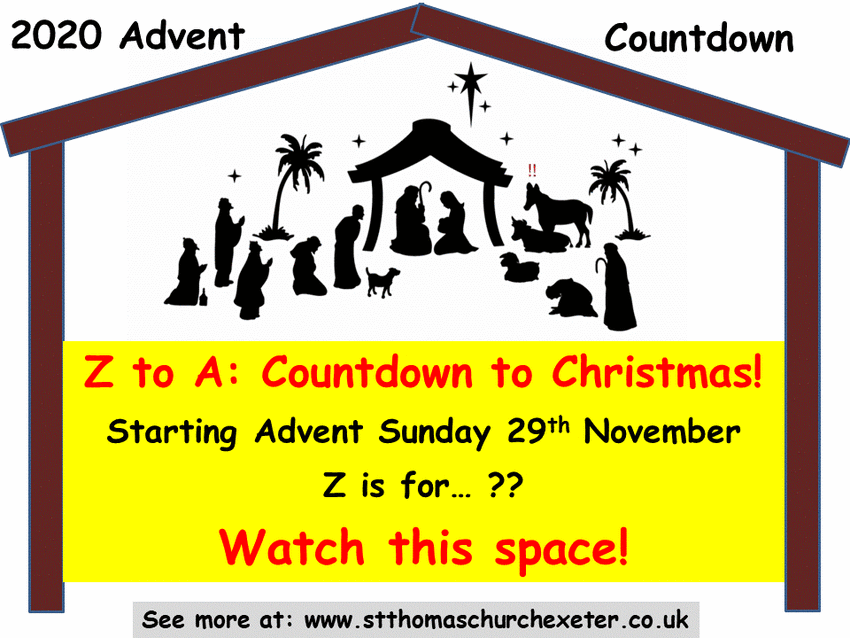
Advent Countdown - coming soon!!
Starting on Advent Sunday, 29th November, we will be working backwards through the alphabet, from Z to A, as we count down the 26 days to Christmas.
Each day we will look at someone or something connected with the Christmas story, or with our Christmas traditions, linked to that day's letter.
There will be posters on our church noticeboard on Cowick St, and in the window of the church hall, and there will be articles here on the St Thomas Blog. Check them out daily!
We start with the letter Z - who or what do you think that will be?

